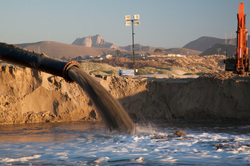Beach Reclamation
S5E1 Students will identify surface features of the Earth caused by constructive and destructive processes.
c. Relate the role of technology and human intervention in the control of constructive and destructive processes.
Examples include, but are not limited to:
c. Relate the role of technology and human intervention in the control of constructive and destructive processes.
Examples include, but are not limited to:
- Beach Reclamation (Georgia Coastal Islands)
What is beach reclamation?
Beach reclamation is simply providing more sand for a beach that is eroding. I have linked a site that has a terrific explanation of dredging, which is a common method of beach reclamation. Beach reclamation is beneficial for land owners who own beachfront property, because nice beaches make their property more valuable. In addition it helps to keep beachfront buildings safer from erosion damage, but recent studies such as the CBS news video below, suggest that beach reclamation is a waste of money. According to the video beaches that have been nourished or reclaimed erode 2 to 12 times quicker than an ordinary beach. Beach replenishment is a constant issue.
The two videos below don't provide tons of information, but allow you to get a good visual of how the process works. The first video shows dredged sand being pumped onto the beach. The water runs off, back into the ocean and the sand is then pushed around where it is needed. The second video shows how dredging is used to clear sand from boat passageways and harbors. In the video you can also see the Jetty's jutting out trying to preserve the passageway to the harbor. When the jetties don't fully do their job, dredging becomes necessary. Here is a great link about a county in Florida that just completed a beach reclamation project.
|
Georgia's Coastal IslandsStudies of the historical changes in the mean high-water shoreline of Georgia indicate that the basic causes of shoreline erosion are:
—The worldwide rise in sea level (an average of one to two feet per century); —Seasonal storms and hurricanes. The Georgia coast has not had a major hurricane (defined as at least a category 3 hurricane) since the late 1890s; —Man's activities, including channel dredging with offshore disposal of dredged material, jetty construction, shoreline structures, and damming of rivers. Georgia's coast islands and beaches are composed largely of sediment which has eroded from the highland and mountainous regions further inland. This first video is linked to a 30 minute video all about Georgia's coastal islands. The second video is a bit longer and goes into a bit more detail and gives the full history of Georgia's coastal islands. Jetties
Jetty's are long narrow barriers, often made of rock, which prevent waves from washing sand into harbors. They also prevent large waves from crashing in the harbor. In some places like Charleston South Carolina, long jetties allow large ships to travel through long channels into Charleston Harbor.
|
